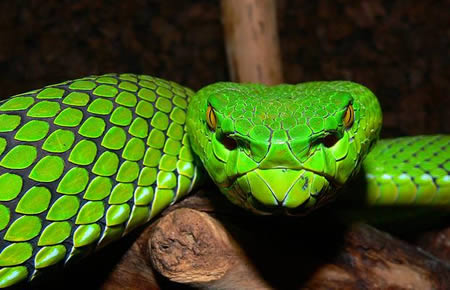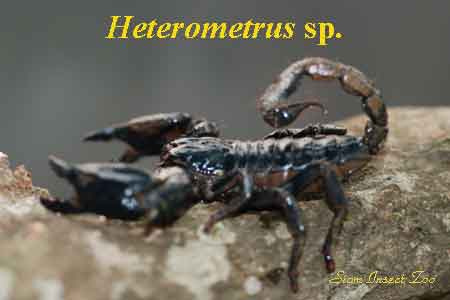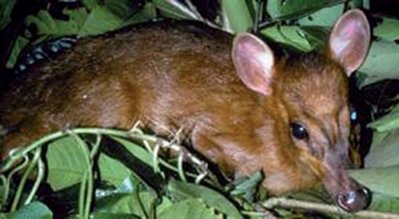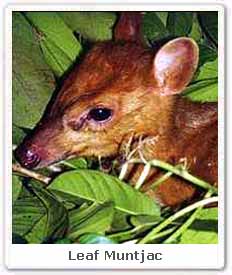Yeti Hope: Leaf Muntjac Among 350 New Himalayan Species
Posted by: Loren Coleman on August 11th, 2009
In the midst of the media frenzy this week about all the new animals that have been discovered in the Himalayas, the Thaindian News of Nepal expresses thoughts similar to my own, sort of. In “New Nepal Wildlife Discovery Boosts Yeti Fantasies,” the newspaper notes: “Almost 50 years after an expedition by Everest conqueror Sir Edmund Hillary to track down the elusive Yeti of the Himalayas failed, there is fresh hope for the existence of the mythical half ape, half man with the discovery of 350 new species, 94 of which are in Nepal alone.”
Mythical? Not at all. Fantasies? Hardly.
A tiny deer, a flying frog, a venomous snake, new birds and catfish that stick to rocks and 350 other species have been discovered over the past decade in the Himalayas, and the World Wildlife Fund wants us to be aware the region should be saved.
The World Wildlife Fund, in a flood of press releases this week, proclaimed that almost three-quarters of the finds between 1998 and 2008 were plants, including 21 new orchid species. On the list, as well, were 16 amphibians, 16 reptiles, 14 fish, two birds, two mammals and at least 60 new invertebrates. The majority of the new discoveries have already been reported in peer-reviewed, scientific journals.
Among the most amazing find was the miniature muntjac, leaf muntjac, leaf deer or Putao muntjac (Muntiacus putaoensis). The world’s smallest deer species (shown above) stands just 60-80 centimeters (25-30 inches) tall and weighs about 24 pounds (11 kilograms).
This small deer was discovered in 1997, by biologist Alan Rabinowitz during his field study in the isolated Naungmung Township in Myanmar, and written up scientifically in 1999. Rabinowitz found the species by examining the small carcass of a deer that he initially believed was the juvenile of another species; however, it proved to be the carcass of an adult female. He managed to obtain specimens, from which DNA analysis revealed a new cervid species. Local hunters knew of the species and called it the “leaf deer” because its body could be completely wrapped by a single large leaf.
The leaf muntjac is uniquely found in dense forests of Myanmar, in the Hukawng Valley region to the Northeast of Putao, hence its scientific epithet, and to the south of the Nam Tamai branch of the Mai Hka River. It is known at an altitude of 450 to 600 m — the transition zone between tropical forests and temperate ones. In 2002, it was discovered also to exist in Namdapha Tiger Reserve in eastern Arunachal Pradesh, India. It has also been noted from the Lohit and Changlang region and near Noklak in Nagaland. It probably inhabits suitable habitat over the entire junction of the Pātkai Bum and the Kumon Taungdan ranges.

Also discovered was a new flying frog from near Assam, India.
Scientists found Rhacophorus suffry, a bright green frog in northeast India that uses its long, webbed feet to glide in the air. They additionally discovered two chocolate-brown catfish from Nepal that have evolved unique adhesive undersides to stick to rocks in fast-moving streams.

The venomous Gumprecht’s green pit viper can grow up to 4.3 feet (1.3 meters) long. Originally discovered in Thailand in 2002, the snake is also found in the mountains of Myanmar (Burma).

A relative of the newly discovered Nepalese scorpion.
Oh yes, back to that Nepalese newspaper. It points out that, “One of the most remarkable discoveries in Nepal was the Heterometrus nepalensis, a scorpion discovered in the Chitwan National Park in southern Nepal. It is the first species of scorpion ever to be discovered in the country.”

One reason the WWF is worried about disappearing species. Will canned Yeti be a cuisine of the future?
For cryptozoology, the fact that new animals are being discovered all the time, ethnoknown locally, is easily translated into more interest for the search for the Yeti:
“With the WWF saying that many new discoveries waiting to be made, there is hope yet for the Yeti, for whom a horde of expeditions have been launched since 1953, when Hillary and Tenzing Norgay Sherpa reported seeing large footprints in the snow which were attributed to the elusive Yeti. Though Hillary’s Yeti expedition was deemed a failure after the skins and scalps it returned with as trophies were found to be bear skins and a goat skull, it has not deterred explorers,” writes Sudeshna Sarkar of the IANS.
These are not “Yeti Fantasies,” but cryptozoology realities.
About Loren Coleman
Loren Coleman is one of the world’s leading cryptozoologists, some say “the” leading living cryptozoologist. Certainly, he is acknowledged as the current living American researcher and writer who has most popularized cryptozoology in the late 20th and early 21st centuries.
Starting his fieldwork and investigations in 1960, after traveling and trekking extensively in pursuit of cryptozoological mysteries, Coleman began writing to share his experiences in 1969. An honorary member of Ivan T. Sanderson’s Society for the Investigation of the Unexplained in the 1970s, Coleman has been bestowed with similar honorary memberships of the North Idaho College Cryptozoology Club in 1983, and in subsequent years, that of the British Columbia Scientific Cryptozoology Club, CryptoSafari International, and other international organizations. He was also a Life Member and Benefactor of the International Society of Cryptozoology (now-defunct).
Loren Coleman’s daily blog, as a member of the Cryptomundo Team, served as an ongoing avenue of communication for the ever-growing body of cryptozoo news from 2005 through 2013. He returned as an infrequent contributor beginning Halloween week of 2015.
Coleman is the founder in 2003, and current director of the International Cryptozoology Museum in Portland, Maine.














Roasted scorpions?… Alright, I suppose, but why canned? They’d have much more flavor if they were packaged some other way.
What a beautiful snake!
I’ve got high hopes for a Yeti discovery, although it may take up to 20 years because of a lack of scientific involvement and treacherous terrain.
– Tim
I hope they find the yeti in my lifetime if there’s anything there to find. But would anybody risk faking footprints in such a harsh enviroment?
The snake is quite striking.
I think that one major reason that animals like these keep getting discovered, and the yeti goes unconfirmed, is simply that scientists follow up almost any evidence for the former, as there are animals like them recognized by science all over.
No one looks askance at following up evidence for a new snake or frog. And why not? Credit for a significant discovery awaits; and science half expects the new critter to be found.
An bipedal manlike primate is, for reasons cultural (and even religious) and otherwise, a different story. You’re not supposed to find them. So no evidence short of absolute proof is either accepted or followed up.
Yeti (and sasquatch) expeditions have one characteristic constantly misrepresented by skeptics and the public at large: they almost always come up with evidence of the kind that gets followed up …with other kinds of animals. But with these animals, the search winds up (as it almost inevitably will on the short fuses such searches have) short of proof, and what has been found isn’t run to ground as it is with conventionally accepted animals.